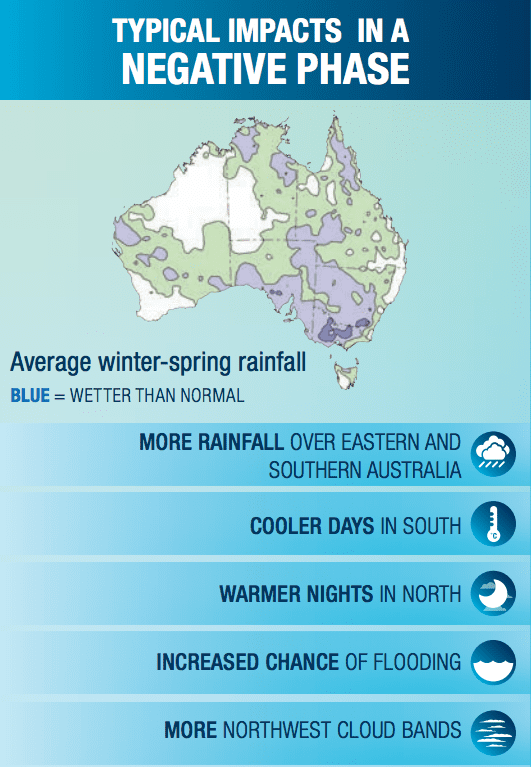 The most recent weekly IOD index value is −0.37 °C, with easterly winds across the tropical eastern Indian Ocean over the past week acting to ease the negative IOD values somewhat.
The most recent weekly IOD index value is −0.37 °C, with easterly winds across the tropical eastern Indian Ocean over the past week acting to ease the negative IOD values somewhat.
However, this is likely to be only temporary, with most climate models surveyed by the Bureau predicting negative IOD conditions are likely to persist during spring.
The Indian Ocean Dipole is the difference in ocean temperatures between the west and east tropical Indian Ocean, that can shift moisture towards or away from Australia
The El Niño–Southern Oscillation (ENSO) remains neutral with most oceanic and atmospheric indicators within the neutral range. The Southern Oscillation Index (SOI), which recently had moderately strong La Niña-like values, has returned to neutral values, with the 30-day value to 15 August at +6.3. Most climate model outlooks indicate the central tropical Pacific is likely to cool over the coming months, but remain ENSO-neutral. Three of seven models surveyed by the Bureau are indicating this cooling will be enough to reach La Niña thresholds in spring, but only one of these persists for longer than one month. This cooling of the tropical Pacific may be contributing to the wetter than median rainfall outlooks in Australia, along with the negative IOD.
The Southern Annular Mode (SAM) index has recently dipped to negative values but is forecast to return to neutral levels in the coming days, and remain so for the next fortnight. A neutral SAM has little influence on Australian climate.
The Madden–Julian Oscillation (MJO) is currently in the western Indian Ocean. Most climate models indicate the MJO will remain slow moving in this region this week. An MJO in the western Indian Ocean has little influence on Australian rainfall patterns, but typically acts to increase cloudiness and rainfall across much of the northern Indian Ocean and increase tropical Pacific trade winds.
Climate change continues to influence Australian and global climate. Australia’s climate has warmed by 1.44 ± 0.24 °C over 1910–2019, while southern Australia has seen a reduction of 10–20% in cool season (April–October) rainfall in recent decades.

HAVE YOUR SAY